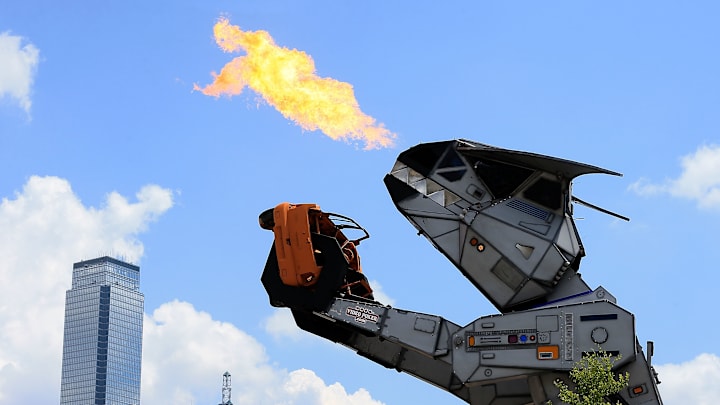When Doug Malewicki attended his first monster truck car show in the late 1980s, he walked away thinking it was extremely stupid. Giant, oversized trucks battering and steamrolling junk cars? Silly.
But Malewicki couldn’t help but think about the possibilities. What if he could craft a car-eating robot? What if it resembled a Tyrannosaurus rex? What if it could breathe fire? And then transform into a trailer?
These were the thoughts of 14-year-old boys doodling on loose-leaf paper. But Malewicki was an accomplished inventor. And after two years of development, his adolescent fantasy came true. Robosaurus was born.
From Card Games to Car Chewers
Malewicki, who was born in Illinois, got his start in engineering with North American Aviation, helping design escape pods for NASA's Apollo astronauts in the 1960s. After moving to California, he started AeroVisions, which was the incubator for a series of inventions. He designed the Skycycle, a jet-powered motorcycle operated by daredevil Evil Knievel in his failed bid to jump Snake River Canyon; a prototype car, the California Commuter, got 157 miles to the gallon; a 400-horsepower electric car reached speeds of 250 miles per hour; but his biggest hit was an apocalyptic card game, Nuclear War, that became a bestseller.
Robosaurus was something else entirely. After being inspired at the monster truck show, Malewicki assembled a crew of partners and engineers. With Gary Cerveny and Mark Hays, he formed Monster Robots, Inc., and raised roughly $2 million to fund his ambition.
Malewicki sorted out the hydraulics needed for Robosaurus, which was to stand 40 feet tall and weigh in at approximately 56,000 pounds. The goal was to craft a robot that was articulated enough to pick up a car, “chew” it by crushing it with its mandibles, and then discard it. If the robot felt like ingesting something cooked, it could spew fire from flamethrowers placed in its mouth to toast the vehicle first. Two operators would be hidden in the beast’s skull to operate it.
“It’s King Kong, Godzilla, and Star Wars rolled into one,” Malewicki said in 1990.
One Robot, Two Patents
It was Hays who had the idea to make Robosaurus a homage to Transformers, the robot toy line that exploded in popularity in the 1980s. When he was done dining on vehicles, Robosaurus would collapse into a trailer, which also made it portable. It resulted in two patents—one for a “trailerable robot for crushing vehicles” and one for “monster toy robot.”
Robosaurus made quite an impression when it debuted in 1990. “It spits fire as far as 20 feet, and it emits red smoke from behind what looks to be its head,” wrote Los Angeles Times columnist Scott Miller. “It is loaded with woofers hiding in secret compartments for sound effects. It looks like something from a space movie. It sounds like a giant video game.”
Robosaurus popped up at events with names like the Coors Extra Gold Motor Spectacular. Although it could roll short distances on rear tires, it could be tied to a vehicle for towing from one event to the next. And although it couldn’t exactly “transform,” it could collapse to make moving it easier.
Once in place, Robosaurus got to work. Rear tires allowed it to scoot into position, where its claws could act as a jack for a hapless car. Once it got hold of the vehicle, foot-long teeth “bit” into the chassis it held with lobster-like pincers. It might get only a nibble of the roof before the car was crushed in its grasp. Sometimes, it would attend air shows and masticate small propeller planes.
Some children, cowed by the sight of a fire-breathing, car-ingesting monster, were apprehensive about Robosaurus. Later, Hays said, the kids would be “begging to go back” the next day.
Justice Denied
The potential for Robosaurus to become a multimedia sensation was not lost on Hollywood. In 1992, the attraction acted as the basis for the NBC television pilot Steel Justice. In the not-distant future, cop David Nash is grieving over his young son, who has been killed by a roving gang. David soon encounters a shaman named Jeremiah, who magically transforms his son’s small Robosaurus toy into a 40-foot-tall weapon of destruction. In spite of (or due to) this berserk premise, the series failed to make it to air.
In 2008, Malewicki and partners decided Robosaurus needed a new home. They placed the robot up for auction via Barrett-Jackson’s car collector event in Scottsdale, Arizona, where it was expected to fetch as much as $5 million, the rough cost of trying to build it from scratch. Ultimately, it sold for $632,500 to a buyer named Brooke Dunn out of Las Vegas: Dunn later took it to display on the Vegas Strip during a Barrett-Jackson auction in the city. The somewhat unwieldy mechanical beast damaged a streetlight, but nothing else was harmed.
In 2011, Robosaurus appeared on The History Channel series Pawn Stars with a price tag of $1 million. The show’s proprietors declined the offer. The robot has continued to make appearances at events, though there have been few updates to its official Facebook page since 2020.
Why didn‘t Robosaurus retain its 1990s momentum? It could be that, despite the dramatic car-munching spectacle, the tedium of actually eating one wasn't terribly exciting. (Robosaurus needed several minutes to grasp and hoist its meal.) In today's era of CGI dinosaurs, perhaps Robosaurus is considered quaint. But there's still something quintessentially American about its invention, in which a man believed there to be need for a car-eating robot dinosaur and then set about making one.
